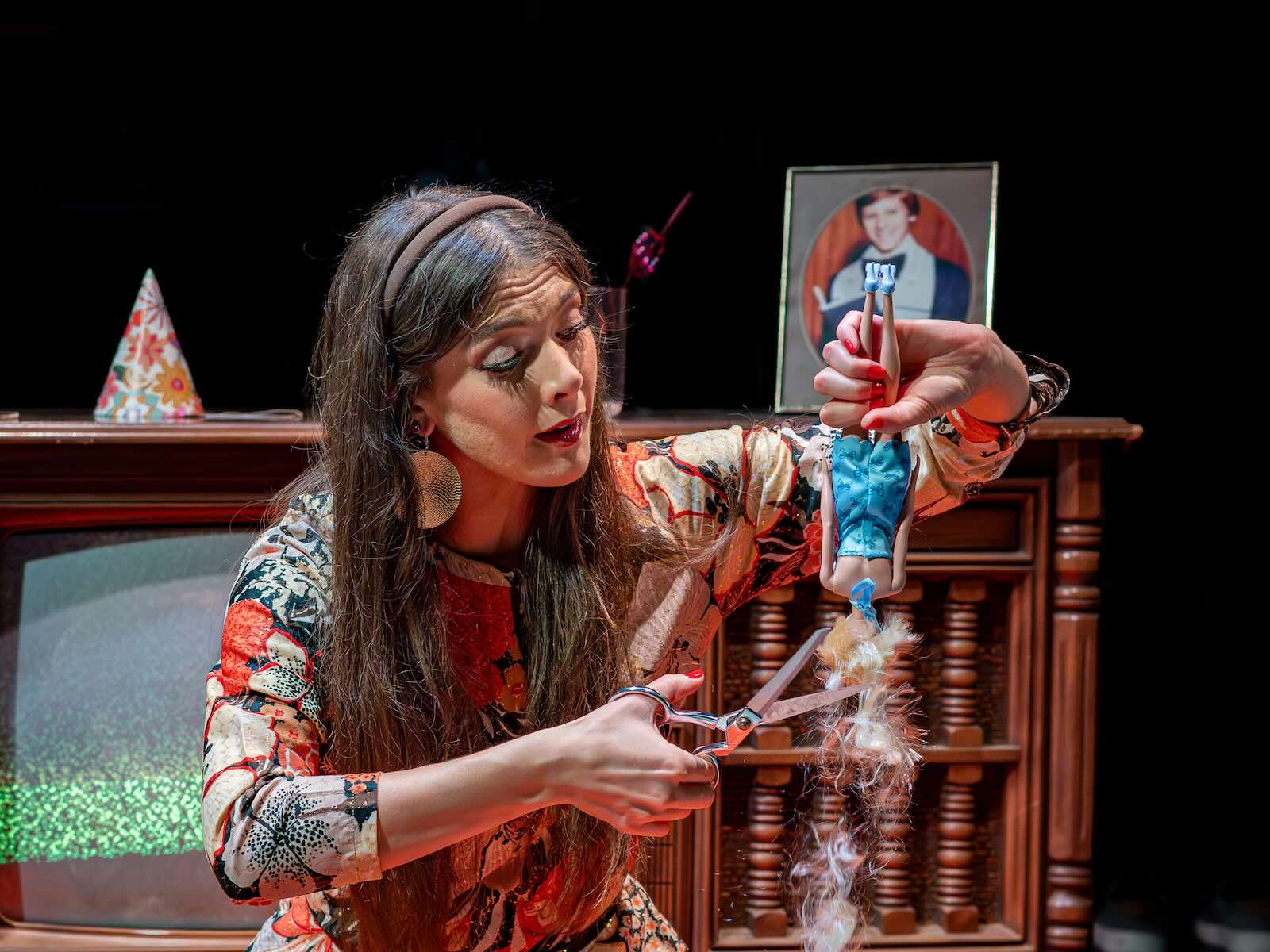In the Biblical story of Salome and the Dance of the Seven Veils, a teenage princess named Salome performs a seductive dance for her father, King Herod, who promises her anything she desires, with bloody consequences. If you’ve ever heard this story— and of Salome’s desire for the head of John the Baptist — then you’ve heard the story that baroque composer Alessandro Stradella and librettist Ansaldo Ansaldi set to music in 1675 and called St. John the Baptist. This IN Series production — with new English text by Bari Biern — is the world premiere of this piece.
The story has been notably adapted before: as an opera by Richard Strauss, and as a play by Oscar Wilde. Both of these versions were banned at various times for the portrayal of necrophilia and young lust. (Salome is 13.) The Stradella/Ansaldo version focuses more on Herod’s suppression of his own inner voice and John the Baptist’s efforts to draw that inner voice forth, with the homosocial and homosexual implications such an action might have.

This is a story that is filled with the same shocking moral corruption, rot, and insult as we currently contemplate with the Epstein files and the Trump regime. And director Timothy Nelson and his production crew at IN Series dig into this material with relentless fervor, zest, and rigor.
In contradistinction to the deadening malaise of the subject matter, John the Baptist is filled from the first moment to the last with some of the most gorgeous, constantly moving, rejuvenating, and uplifting baroque music you will hear anywhere.
To pull this off, in the entirety of the opera, there are only five actors on stage, accompanied by the cracker-jack orchestra (INnovātiō Baroque Orchestra) under Nelson’s incisive conducting. As far as I’m concerned, the IN Series production of Stradella’s St. John the Baptist is a colossal achievement of imagination and skill.
Rather than replicating a Biblical epic, the way Cecil B. DeMille films did for Baby Boomers and their parents, Nelson has placed the opera in what looks like a late 1960s-’70s suburban America. Josh Sticklin’s set design is full of cheap, unrecyclable, and undigestible abundance, creating a world that fosters isolation and dread. Just from looking at the set, you get the feeling that, clearly, nothing good can happen here, despite all of the beautiful music in which we are immersed. The polyester clothes designed by Oana Botez don’t allow the bodies of the people to breathe. The constant accompaniment of black-and-white television “interference” (lighting design by Yannick Godts) doesn’t allow for human feeling. We see why Salome, an only child, is unable to develop healthy connections with others, with disastrous consequences.
The audience is introduced to the Herod household as soon as they enter the theater, and before hearing a note of music: As we take our seats, we see Herodiade, Herod’s wife, played by Hayley Abramowitz, troweling icing onto a depressingly American birthday cake intended to cheer Herod up, cigarette dangling precipitously from her darkly glossed lips, her face framed by hair that is cut in an assertively geometric style. Heriodiade longs for sexual connection with her husband but makes do with her husband’s sleazy brother, The Counselor (Greg Sliskovich). Herod (Andrew Adelsberger) is likable enough. But mostly he seems depressed and tends to blend into the wall work. The rest of the family spends all of their energy trying to bring him out, with Salome being the most successful at this. Adelsberger easily garners our patience and attention just as Herod garners that of the rest of the people around him.

This next part I may have completely wrong. No one has claimed that this was part of the planned production on stage. However, this is the only way I can explain cogently what I saw.
In a gesture that reaches back to commedia dell’arte conventions, in which characters onstage are costumed as recognizable stock types (such as servants, wealthy old men, young lovers, self-styled captains), Nelson has chosen to have some of his cast look like instantly recognizable roles or archetypes from iconic movies. Of this cast, St. John the Baptist and Salome are each most obviously and pointedly dressed as an identifiable type. St. John is costumed as The Farmhand (specifically for our 21st-century reference, he is dressed and coiffed like Jake Gyllenhaal’s ranch hand Jack Twist in the movie Brokeback Mountain). Salome is similarly dressed as The Innocent Little Girl (specifically, she is dressed and coifed like Patty McCormack from the 1950s movie The Bad Seed, including her iconic pigtails). This choice in costuming has sizable payoffs as the show progresses.
John the Baptist is played by Daniel Moody, whose glorious countertenor comes through in the oratorio’s earliest musical moments as he sings of his plans to leave his current way of living in nature to preach to and reclaim the soul of Herod. Moody’s John the Baptist exudes a transcendent personal conviction (bordering on arrogance, to be honest) of the glory and healing effect that God’s love can have on one’s life.
The bulk of the rest of the production belongs to Dawna Rae Warren (Salome), whose singing and acting embody monumental strength, flexibility, and endurance as she berates her father to give her what she wants. Warren’s voice moves from low, guttural contralto reprimands to soprano howls emitted while climbing on top of the torture chamber in which John the Baptist is confined. Her appeals are unrepentant and unrelenting. Because of this, the last two-thirds of the second act belong to Salome regardless of whoever else is onstage.
The archetypal costuming I mentioned earlier may serve as masks, providing a kind of distancing for the performers, giving them permission to be bigger and more intense in their performances. All of these performers are well-trained, with voices that are facile, focused, and bold instruments. They apply their craft and talent unapologetically. These are not fragile artists onstage. And the audience is the better for it. I thought Warren’s Salome would get tired or at least slow down as the show neared the end. She didn’t. As a fellow audience member noted, “She was in the zone.”
Finally, a word about librettist Bari Biern. If librettists are not as well known as an opera’s composers, maybe it’s because when a librettist is doing their job, they meld with the work of the composer, and the work becomes one blended entity. Librettist Bari Biern’s work in John the Baptist blends into Stradella’s (and Timothy Nelson’s). Her words fit into the story and the conceit of this production, urging both the characters and the audience along. It’s in large part because of Biern’s deft use of language that the audience is able to take in some of the large musical, emotional, and conceptual leaps that it does.
Running Time: Approximately 90 minutes including one intermission.
St. John the Baptist played October 2 to 5, 2025, presented by IN Series and Catapult Opera, performing at Pop-Up Theater, 340 Maple Drive (IN Series’ new venue in Southwest DC). St. John the Baptist also plays October 10, 11, and 12, 2025, at the Baltimore Theatre Project, 45 West Preston St., Baltimore, MD. Tickets range from $25 to $35 in Baltimore and can be purchased online or by calling 410-752-8558.
The cast and creative team bios are online here.
St. John the Baptist
Music by Alessandro Stradella
New English Text by Bari Biern
CAST
Hayley Abramowitz: Herodiade; Andrew Adelsberger: Herod; Daniel Moody: St. John; Dawna Rae Warren: Salome; Greg Sliskovich: The Counselor
PRODUCTION TEAM
Stage and Music Director: Timothy Nelson; Set Design: Josh Sticklin; Lighting Design: Yannick Goats; Costume Design: Oana Botez
INNOVATIO BAROQUE ORCHESTRA
Violins: Risa Browder, Keats Dieffenbach, Rebecca Nelson, Leslie Nẻo, Zoe Kunubar. Viola: Asa Zimmerman; Violincellos: JohnMoran, Alexa Pilon; Bass: Jessica Powell Eig; Theorbo: Cameron Welke; Harpsichord/Organ: Paula Maust and Timothy Nelson
SEE ALSO:
Timothy Nelson on staging the shocking opera ‘St. John the Baptist’ (interview by Rasheeda Amina Campbell, September 19, 2025)



